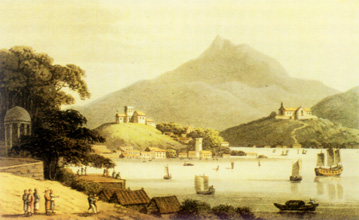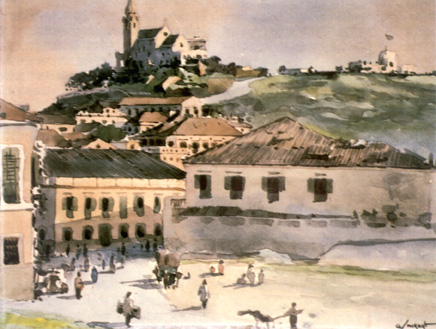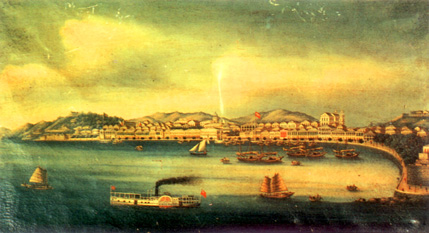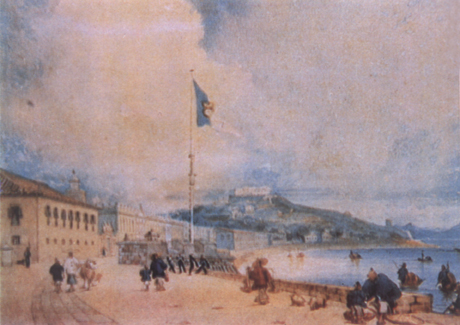 View of Macao from the Camões Garden.
After a drawing by CLARK WALTON.
Colour aquatint. 1814.
Luís de Camões Museum/Leal Senado Macao.
View of Macao from the Camões Garden.
After a drawing by CLARK WALTON.
Colour aquatint. 1814.
Luís de Camões Museum/Leal Senado Macao.
At the intersection of five streets, at the beginning of Rua da Barra (Barra Street), under the shadow of some banyan trees, is the Praça da Fonte do Nilau (Square of the Nilau Fountain) (nowadays improperly pronounced 'Lilau'). The Chinese call it Grandmother's Well or Ancestor's Well and some hawkers have set their stalls there.
'Nilau' derives from the Guangdongnese word nei-lau (spring from the mountain).
The mountain and the spring are associated as representing the two established dimensions of Man and his worldly life: the horizontality or immanence with the matter (the Mater, which always generates even, or especially when, interring); and the verticality, which is enough, in itself, to evoke the transcendence of the spirit. The spring water flows from the heights (clouds and mountains), thus symbolizing the union of Heaven and Earth.
Nilau was the original Chinese name until 1622, of Penha Hill. The Fountain of Nilau was, according to Records dated the 14th of April 1784, "the main fountain of this city" — a pleasant retreat close to the bay, the Temple of Ma-chou (Grandmother — meaning also the first female ancestor) and the manor houses of the Portuguese. With its fengshui (feng = wind + shui = water) or geomancy, its strategic location, and the importance of the vital values in the economy of humankind and other imponderable factors, transformed the Fountain of Nilau into a kind of myth; a meeting of Luso—Chinese in permanence.
"Those who drink water from Nilau
Will never forget Macao:
Will either marry in Macao
Or will come back to Macao."1
The cult of water, the fundamental element and the strength of organic life, explains the great importance of fountains, springs, and aqueducts in the nomenclature for places and the monumental urbanism of old and modern towns. The Greeks had the Castalia Fountain; the Romans, the Bandusia; and the Macanese, the Nilau.
Around a spring, plants, animals, and human life germinates. Macao was also born and developed; always equal to itself and always more and more in actuality — around the Fountain of Nilau.
The Portuguese sailors, coming ashore around 1553, took the water they needed to replenish their ships and put out their wet merchandise to dry near the Ma-chou Temple on the slope of Nilau Hill. Behind the house which today is the Capitania dos Portos (Port Authority), one can still admire the vestiges of a reservoir from the old times which served to supply the ships. The Beach of the Manduco, also called of the "Penedo em forma de rã" (lit.: "Frog-Boulder" Beach) was, together with Tarrafeiro and Patane, where all the movement of the ships took place. It was where the Portuguese and the Fukiennese, "always on the move and saying goodbye", constructed their shipyards. In our days, this was the place chosen, and very aptly, to site the Museum Marítimo (Maritime Museum), inaugurated in 1987.
Macao has never known the 'drums of war' and is only used to listening to the sound of the waves, the departure and arrival of big ships and the fishermen's boats taking shelter.
It was not just by chance that in 1555 and 1556, two of the most famous writers and adventurers of Portugal, Fernão Mendes Pinto and Luís Vaz de Camões lived in Amagau or Macuón, near the Fountain of Nilau. They were, respectively, the nomad of the Oceans and the lyricist — always pining for our soul's Motherland, "pelo mundo em pedaços repartida" ("dispersed like pieces around the world").
Here converged and developed the two related feelings of nostalgia of the Chinese and the Portuguese. As a matter of fact, the three basic realities: time, distance and company, being the constituting elements of concrete human existence, comprise the structural elements of any nostalgic experience. There is no nostalgia without time, without distance, at least psychological (inner space), and without a relationship of 'otherness'. The Portuguese word for nostalgia, saudade, means the feeling of being alone or apart from a dear person or belonging. Saudade is a situation of Man, regardless of his Mongol or Celtic blood. Saudade is the feeling of that situation. The psychic life of Man is the same everywhere and his basic aspirations differ very little from place to place. Vertical thought, the over-conceptual comprehension of reality without words, concepts or images, the intuition, the 'science of the heart' and of mystery, mysticism, are common to all men — as a gift from the Creator manifested with more or less evidence.
Apart from this psychological saudade, there is also in every human being, the experience of solitude of being, singularity, sui-dade, because of his contingencies and limitations. It is ontological nostalgia. This solitude generates a dialectic of excelling, an opening to the transcendental, to the Infinite or Absolute. It was not by chance that Portuguese and Chinese met and co-existed in an almost desert peninsula, near a Temple dedicated to the Mother-Goddess.
Amaeru is, for the Japanese, the deepest feeling of loving dependence (maternal love, the feeling of being constantly generated). Is it a mere coincidence that the festivities in honor of T'in Hau (Queen of Heaven), in the Barra Temple, are usually held at the beginning of May, the month of the Virgin Mary and Fátima? All societies were, in the beginning of time, matriarchal, influenced by the Mother. It was the exaggerated machismo which spoiled the world...
 Penha Church from the Inner Harbour.
GEORGE V. SMIRNOFF (°Vladivostock 1903—†Hong Kong 1948).
Watercolour on paper, ca1942—1943.
Luís de Camões Museum/Leal Senado, Macao.
Penha Church from the Inner Harbour.
GEORGE V. SMIRNOFF (°Vladivostock 1903—†Hong Kong 1948).
Watercolour on paper, ca1942—1943.
Luís de Camões Museum/Leal Senado, Macao.
In the psychological plan, the universality of the experience of saudade is more immediate, because it is more transparent. The Fukiennese, who called their village outside the boundaries of the city Mong Há (to have one's eyes in Há-Mun; or: Amoy), the daily experience of their native land—scape and of their separation from it, were and are, by nature, as nostalgic as the Portuguese. They brought here, with them, the feeling of earth; the undifferentiated animism, together with the local gods. The first Portuguese who came to Macao brought with them the fondness for the chapels dedicated to the Holy Mother of God at the top of the hills, for the nearness to the indefinite and friendly sea, the atavistic lyricism of earth and fountains, in both cases, oceanic and especially spiritual nomadism. 2
In that remote sixteenth century, the peninsula and the islands (which included, then, many more than the ones existing now) still belonged both to the coastal sailors or to nobody. As a matter of fact, they belonged mainly to the wakos (dwarf pirates from the Ryukyu Islands), who craved the silk and the porcelain which originated from Fatshán and from Guangzhou (lit.: City of the Goat) to the 'South Ocean' (Nám Teung; or: Indonesia).
 The Praya Grande, in Macao.
Attributed to the Baron of CERCAL. Oil on canvas.
Sociedade de Geografia de Lisboa, (Geographical Society), Lisbon.
The Praya Grande, in Macao.
Attributed to the Baron of CERCAL. Oil on canvas.
Sociedade de Geografia de Lisboa, (Geographical Society), Lisbon.
It seems that Mendes Pinto, who came here in 1555, in the company of Fr. Belchior Nunes Barreto, met at this place, some families of hok-lou (Fukiennese fishermen), living more on their junks than in wood or straw huts, as their actual counterparts still are used to do. In their native dialect, they explained to Mendes Pinto and his companion, the meaning of the name of the village: Amagau (Grandmother's or Female Ancestor's Bay) or Macuón (Grandmother's Port).
The Portuguese helped to unveil the Macanese identity, the outcome of the meeting and acquaintance for a common purpose, between South China Sea sailors and their Portuguese counterparts.
Camões preferred Patane and its boulders, which were then more numerous and bigger than the ones existing now. He had the soul of a poet and a humanist. He sought retirement. He also sought 'the rock', a symbol of permanence.
There is no doubt that Luís Vaz de Camões was in Macao, marking distinctively the beginning of the Portuguese presence here. It is he himself who narrates, in sonnet 128 of the chant X of The Lusiads, his arrival on the coast of Cochin-China, "dos procelosos baixos escapado"3 ("having escaped from the stormy shoals" — Nám Sá, named Parcéis by the Portuguese), and having lost "todo o gado vacum de que grandes soldadas esperava " ("all the cattle from which I expected big revenues") after the cargo was sold, perhaps in Malacca, thanks to the influence of its Captain, Dom Leonis Pereira. Camões dedicated one elegy and one sonnet to him.
On the other hand, a fight took place, in 1556, in the "rada de Macau" ("roadstead of Macao") — as mentioned twice in that document ("ca " — meaning "here" — or in the place where that letter had been written, Macao), the letter from a Portuguese nobleman (possibly Dom Diogo Pereira ) to Fr. Manuel Teixeira, S. J.. This fight involved five—hundred Portuguese troops. The Cancioneiros mentioned by José Hermano Saraiva in his book Vida ignorada de Camões4 seem to be positive assertions of great value. Finally, the name Penedos de Camões (Camoens' Boulders ) given to a site in Macao, which was first pointed out by Teófilo Braga and Jordão de Freitas, stresses the same truth: that there is a vital compromise of presence, service and love created by the Genius of Portugal for Macao.
Each one of the two most universal literates and humanists of Portugal lived, fought, suffered and loved on this fertile soil of the delta of the Si Kian (Western River). The two Portuguese epic works — the classical/Renaissance one (which chants the organized and historical heroism) and the romantic/adventurous one (which praises the filibustering individualism. Swift's style, and Oriental exotism) merged here in Macao, which is not the remainder of acculturation and marginality, but the strategical and economical axis of the Portuguese rule in the Orient, the 'Door of the Cross of Christ' to the Far East.
Both Pinto and Camões probably drank the same water from Nilau, purest in its origin. They did not stay, but other great Portuguese came, attracted by its magic: Barbosa du Bocage, Venceslau de Moraes and Camilo Pessanha. Even the greatest Chinese poets from the Ming Dynasty and from our days were attracted by the emanations of Nilau.
For many years, the Chinese have called that same hill of Nilau, Chue-kau Sán (Bishop's Hill), and they called, as can be seen in maps from about one century ago, Bishop's Beach the small bay South of that hill, which was topped by the chapel built in 1662 and dedicated to Nossa Senhora da Penha de França (lit.: Our Lady of the Rocky Outcrop of France), of Lisbon, and by a fort which was later demolished. The Bishop must have owned there, in the Southeast outskirts, near the tennis court belonging to the Clube Militar (Military Club), a country house, where he would spend the summer near the beach, since the marginal road was only built about seventy years ago. This used to be one of the areas of Macao where were located the rich villas. Later, the Bishop became the owner of the Horta da Mitra (Vegetable garden of the Mitre), under the shadow of the chapel of Nossa Senhora da Guia (lit: Our Lady of Leadership).
We are aware that the term Pátria (Fatherland) has been used in the West since the tenth century to name not the State, which was, then, the Empire, but the Diocese, to which the Bishopric supplied an Administrative structure, kept from the Roman organization. The Bishop (the 'Father' of the Pátria) was thus the political and religious leader.
Therefore, the Church had a positive and important role in the formation of modem Nations and Kingdoms, among which Portugal occupies a relevant place. The ecclesiastical elements, which have nowadays, for the major part, become lay, are the most important among its constitutive elements. Even patriotic feeling has mainly religious roots. Religion and Pátria are, thus, like "[...] the heart and the spirit, inscribed into a territorial frame."5
The Macanese identity was both born and fortified under the shadow of the motherly care of the Church. Portuguese priests appear in the island of Tâm-Mun (Port.: Tamão; or: Dunmen), in the Pearl River and the Lin-ting Sea areas, in Ningpo, Seong-Tch'un (Sanchoan), Leng-Pak-Kau (Lampacao) and Amá-gau (vern. Port.: Amagao, or Macao). We know the names of some of them. Above the Chapel of Santo António (St. Anthony), near the Camoens Grotto and the Tarrafeiro Wharf (lit.: Casting Newt Wharf), the Portuguese built their houses in 1557. São Lourenço (St. Lawrence), at the foot of the Nilau hill, was already a Parish in 1557. 6
Dom Melchior Carneiro and the first resident Bishop of Macao, Dom Leonardo de Sá, lived in a big chão (lit.: flat ground) near the Patane or Camoens' Boulders. In 1595, the Jesuits became the owners of that property, formerly owned by Martim da Rocha Barroso.
We have already mentioned how those two priests were the organizers of religious, medical and social assistance, as well as of the municipal and political life of Macao. As a matter of fact, Western medicine was practised, since 1569, in the Hospital dos Pobres (of the Poor, later, of São Rafael), and the first vaccine was administered here. The pharmacy of the Colégio da Madre de Deus (College of the Holy Mother of God) was the best in the City.
These fundamental works, emanating from the local church, still exist today, having been enlarged. They document and consolidate the foundation and the general acceptance of our stability and government.

View of the Praya Grande with the St. Peter's bulwark.
Unknown artist. Watercolour on paper. First half of the nineteenth century.
Carlos Estorninho Collection, Lisbon.
Dom Melchior Carneiro, Dom Leonardo de Sá, Dom João Casal and other venerable pontiffs who lived, died and were agents of union here - all of them surely drank water from the Fountain of Nilau, which flows from the Bishop's Hill.
Around this hill, which is nowadays the episcopal residence, are the Palace of Santa Sancha [residence of the Governor] and the villas of the main Authorities, including the one belonging to the family of the late President of the Assembleia Legislativa (Legislative Council), Mr. Carlos Correia Paes d'Assumpção, who passed away in 1992. Crowning the hill is located the Chapel of Penha, from the Ecclesiastical Authority. At the foot, in close contact with the Luso-Chinese people, live the Civil, Military and Judicial Authorities.
Above the Penha (lit.: Rocky Outcrop), or, in other words, above the Sai Mong Yeung Sán (lit.: Hill of Seeing West), Macao is firmly and peacefully settled, with its 'eyes' on Portugal, but with its 'feet' steadily settled in China. From here flows the water of physical and spiritual life for the Macanese and 'Chinese sons and daughters of Macao.'
The three hills of Hóng Téng (Port.: Santo Agostinho; or: St. Augustin), Nilau and Barra form the Parish of São Lourenço, one of the earliest in Macao. The former isthmus of Avenida Almeida Ribeiro, which was even covered by water during typhoons, is like a 'neck', separating what we can still call the 'head' of Macao from the rest of the peninsula.
Indeed, it is in this Southern area of Macao that the Governor's Palace and residence are located, the houses of the principal Civil and Military Authorities, the Government Departments, the Leal Senado (Loyal Senate, or Municipal Chamber), the Temple of Barra, after which Macao got its name, the Seminary of São José (St. Joseph) - our older and better preserved architectural ensemble - and the Bishop's residence.
This Southern part of the City of the Holy Name of God was also its best protected one, with its three forts: São Tiago da Barra (St. James of the Bar [of the Port]), where the Captain of the port used to live, with an ammunitions magazine and a chapel (which still exists today); Bom Parto (Good Harbour); and Penha - not to mention the small fort of São Pedro (St. Peter), in Praia Grande, near the place where the statue of Jorge Álvares is presently located.
Then as now, the Nilau overlooked this urban area, the 'head' of Macao. The outline of the coast and the top of the three hills is one of the most beautiful sights of all Macao. The advantage taken of the undulations of the ground to settle the villas, palaces, churches and other buildings, in which the 'Mediterranean style' is manifest, is one of the most picturesque and most beautiful urban landscapes in this geographic area, no matter from where one looks, but especially from the beautifully designed Estrada dos Sete Tanques (Road of the Seven Pools).
The waters from the harbour, sometimes muddy, and the former beach of the Manduco, with its fishing boats, the docks of the Oficinas Navais, the Museu Mantítmo (Maritime Museum) and the wharfs of the Capitania - all give to this part of the town the colour and the scent of the sea, like the large leaves of the lotus, floating in the waters of a lake, give majesty and ballast to its white or red flowers.
The beachfront Avenida da República (Avenue of the Republic) and the new skyscrapers, like Cyclops guarding the Government Palace, although hiding the dome of the Church of São José and the towers of São Lourenço and Santo Agostinho, transfigure the aspect of what remains of the Praia Grande. The Bela Vista Hotel is a Luso-Oriental balcony, on full-moon nights! The bridge General Nobre de Carvalho, built in 1974, especially if viewed by night from one of those three hills or from the marginal road, is fascinating - a dreamy mirage! All the Macanese landscape - a united area - has gained an increased value from the frame given by that allegory, open to progress and to the near and remote future.
The Fountain of Nilau, although it has been blocked and neglected for more than fifty years, by ignorance and fatality, became cosmopolitan and acquired a sense of continuity and hope. It also expanded into other fountains: Fonte da Flora (Fountain of Flora), Fonte da Inveja (Fountain of Envy), Fonte da Solidão (Fountain of Solitude), Fonte do Filósofo (Fountain of the Philosopher), this one in Taipa, among others. It is the blood of our Earth, the life of our Body.
Past, present and future are the same continuous chain of the water of time, which comes from above and animates everything on Earth. The identity of Macao lives in the nature, history and culture of the Luso-Chinese man, who is in harmony with them.
The unmistakable identity of Macao people "lies in the very roots of its humanity, nationality, culture, regionality and nomenclature." (Governor Pinto Machado).
Translated from the Portuguese by: Ana Pinto de Almeida
NOTES
1 "Quem bebe água do Nilau
não esquece mais Macau:
Ou casa aqui em Macau
ou então volta a Macau. "
2 ANTUNES, Alfredo, O Espaço da Saudade, in "Brotéria", Lisboa, Jan. 1983, pp. 38-67.
3CAMÕES, Luís Vaz de, Os Lusíadas, Porto. LeiloIrmãos, Canto X, strophe 109.
4SARAIVA, José Hermano, Vida ignorada de Camões, Mem Martins, Europa América, 1978, pp. 337-338.
5 PIRES, Benjamim Videira, in "Confluência", Macau, nos.l-5 - For an original critical analysis of Fernão Mendes Pinto's Peregrinação, except in what concerns China.
Also see: KATZ, Rebecca, SANTOS, Manolo B. R., trans. A Sátira Social de Fernão Mendes Pinto, Lisboa, Prelo, 1978 - For Fernão Mendes Pinto, exalted as one of the foremost geniuses of [Portuguese] prose, a satirist with world-wide appeal and even more...
6 PIRES, Benjamim Videira, O IV Centenário dos Jesuítas em Macau (1564-1964), Macau, [p. n. n.], 1964, pp. 37-39, and specially n.54.
*BA in Portuguese Literature and Philosophy from the Universidade de Lisboa (University of Lisbon), Lisbon. Researcher in Portuguese History in the East and the Jesuit Missions in Asia. Author of numerous articles and publications on related topics. Member of the Portuguese Academy of History, Governor of the International Association of Historians on Asia, and other Institutions.
start p. 5
end p.